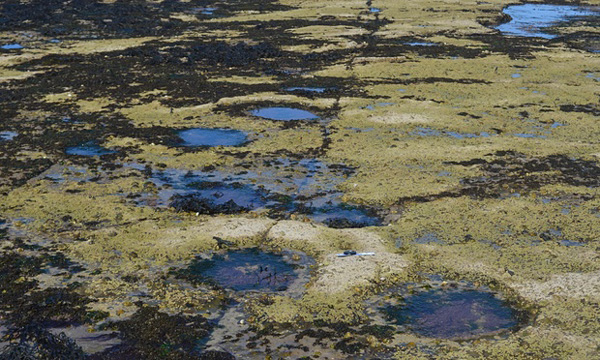ScotHole: they thought it was a pothole. It turned out to be a dinosaur footprint

The Loch Ness monster, Scotch Whisky, the kilt, and a family of dinosaurs - Scotland has it all. At least three of those anyway.
Though dinosaurs have long been dead, a team of researchers have discovered extensive footprint tracks of sauropods - mammoth long-necked dinos - in the Isle of Skye, making the region the largest dinosaur site in Scotland.
The findings have just been published in the Scottish Journal of Geology. The footprints, on a stretch of rock jutting out to the sea, were made by a team of researchers from Edinburgh University, led by paleontologist Stephen Brusatte. The team was there on fieldwork in collaboration with Skye's Staffin Museum and the National Museum of Scotland when they chanced upon the sauropd tracks.
"We had gone out to a lonely stretch of coast on the far northeastern tip of the island," said Brusatte to National Geographic. After spending some time there Tom Challands and he, a fossil fish expert, stumbled upon what looked to be a pothole.
It turned out to be a dinosaur footprint.
The tracks covered an area of about 49 ft (15m) by 82 ft (25m). They were so chaotic, remarked Brusatte, that "it looks like a dance floor, like a dinosaur disco."
From the size and nature of the footprints, the team has been able to infer that they date back at least to the Middle Jurassic age.

Photo: University of Edinburgh
That's 161 million years ago. Even before Chuck Norris was born.
The largest footprint measures an approximate of 2.3 ft (70 centimeters) across. The sheer scale narrowed down the kind of dinosaurs that are likely to cause such massive prints, said Brusatte to Live Science. He also explained that the sauropods were likely to have been at least 49 ft (15m) long and weighed about 11 tons (10 metric tons).
Sauropods were amongst the largest dinosaurs to have ever walked on the face of the planet. Traces of their existence have also been found elsewhere in recent times.
Earlier this year, a fossil site of another new species belonging to the mamenchisaurids family (a type of sauropod), was discovered in China.
It was, rather predictably, named the 'Dragon of Qijiang.'
The findings, published in the Journal of Vertebrate Palaeontology, say that the 'dragon' could've been about 15 metres in length.
In June this year, Professor Phil Manning identified Britain's oldest sauropod dinosaur. The story of the actual discovery of the fossil bone, is rather dramatic.
Manning was walking along a North Yorkshire shoreline when a heavy chunk of rock fell off a nearby cliff, almost on top of him.
As it turned out, that was a fossilised backbone which he and his team at Manchester University studied before recently identifying it to be the of the oldest British sauropod. In sharp contrast to China's fertile imagination, though, this dino has been named Alan.
We seem disposed to like sauropods, at least going by pop culture. Their ambling, plant-eating lifestyle has meant they are seen as friendly creatures, despite their incredible proportions. They're certainly shown to be friendlier than that much dreaded carnivore T-Rex. The 1993-film Jurassic Park started the trend of showcasing dinos according to behavioural/eating patterns (sauropods good, velociraptors bad, T-Rex very bad) and that continues till today - Disney-Pixar just released The Good Dinosaur, an animated film with Arlo, a friendly sauropod, as a central character.
Clearly, not only were they plant-loving, going by how much they seemed to get around, the sauropods were pretty travel-happy as well. Here's to Scotland's newest - or should that be oldest - tourists.
PS: Remember "She sells seashells by the seashore"? The famous 1908 tongue twister is based on the life of one England-born Mary Anning, fossil collector/dealer and paleontologist. She was instrumental in discovering the first Ichthyosaur fossil way back in the 1800s, and continued to make other major findings of dinosaur fossils. Since she came from a poor family she supported herself by selling these sea-shell like fossils as curios to tourists.
And therein lies the origin of the twister!







![BJP's Kapil Mishra recreates Shankar Mahadevan’s ‘Breathless’ song to highlight Delhi pollution [WATCH] BJP's Kapil Mishra recreates Shankar Mahadevan’s ‘Breathless’ song to highlight Delhi pollution [WATCH]](https://images.catchnews.com/upload/2022/11/03/kapil-mishra_240884_300x172.png)

![Anupam Kher shares pictures of his toned body on 67th birthday [MUST SEE] Anupam Kher shares pictures of his toned body on 67th birthday [MUST SEE]](https://images.catchnews.com/upload/2022/03/07/Anupam_kher_231145_300x172.jpg)






